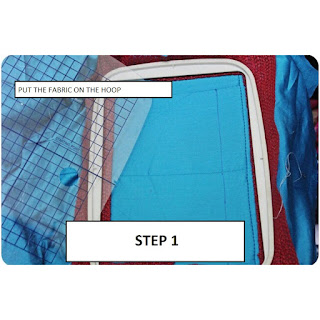 Making customized baby burp cloths as part of a gift set for friends who are expecting or who have new babies. It has been a fun way to learn and to get to know my machine. The mommies are always so excited so it really is encouraging! This post shows how to make embroidery on burp cloths.
Making customized baby burp cloths as part of a gift set for friends who are expecting or who have new babies. It has been a fun way to learn and to get to know my machine. The mommies are always so excited so it really is encouraging! This post shows how to make embroidery on burp cloths.
This method uses a cloth diaper as a base.This method fully encloses the back side of the diaper (so that none of the back of the stitching is visible) and has decorative fabric ends so that the project is fully finished!
Create a design and make sure to include a basting box. Print off a paper version of the design using the software and copy the design on a USB drive and move it to machine.
Diapers will shrink so the first thing we do is to wash and dry them. Wash them with hot water and no detergent and dry with regular heat. (This project does not use any applique, but when do applique designs on a burp cloths, pre-wash and dry those fabrics too. Iron with starch on the fronts and apply Heat N Bond light on the back sides of the applique fabrics).
Once washed, iron the diaper to try to get back to a smooth, rectangular shape, pulling on grain diagonally if needed.
Cut off one end at a 90 degree angle from the sides. Since it won't be straight on the end after washing, this will also help the finished project to be straight.
Flip it over to the back and, using a seam ripper, carefully and quickly remove the two inside stitching lines that hold the padding in place. like this kind of diaper because the padding adds dimension to the stitching (it is even more fun with applique). Open it enough so that the design will fit. Goal here is to stitch on the front and padding and then re-stitch the backing down to cover the back stitches of the embroidery and/or applique. use paper pattern to help decided how much stitching to remove.
Hoop medium-weight cut-away stabilizer. It will be completely hidden on the finished project because it will be enclosed in the diaper. Used cut-away because the stitching will hold up to even the roughest laundering situations, as is often the case on things made to be covered in messes.
Flip the diaper back over to the right side and determine where we want the applique design to be placed. Use the paper print out to do this.
Use a thumbtack method to transfer the position of design instead of making marks on the fabric. ( place paper pattern on the hoop, matching cross-hairs, then place thumbtacks at the center and on one leg of one axis. The thumbtacks leave marks on the paper pattern. Move the paper pattern off the hooped stabilizer. Spray my hooped and marked stabilizer with textile adhesive. Move the paper pattern to the diaper and place it using a ruler to find the center. Tape the pattern in place and pick up the diaper with taped-on design and lay it on the hoop, making sure the thumbtacks go in the exact same holes as before. Remove the thumbtacks and smooth the fabric on the hoop to best adhere it. Diaper is now floated in place on my hoop and temporarily attached with spray adhesive. Roll up the sides and pin or clip out of the way to prevent them from accidentally getting stitched under the hoop.

Top with the filmy kind of Water Soluble Stabilizer (WSS) because the padding of the diaper can cause the stitches to sink down; this will prevent that. Begin stitch out, making sure that basting box is the first sewing step. This holds the diaper on the hoop, as the textile adhesive is only temporary. It is even more important for those diaper burp pads that use applique!
used the machine to do the embroidery.This machine is a single needle with a hoop.
After the design is complete, remove from the hoop, clip all jump stitches on the front and as many as possible on the back. The back won't show so it is not imperative to do this perfectly on the back, but long threads should be clipped. remove all the WSS. use the end of Stitch Fix seam ripper .
trim the cut-away stabilizer close to the the design.
straighten out the diaper and place the back pieces in their original places so that it looks like it did at the beginning.
Then take the diaper to the sewing machine and stitch up the inside lines that had removed previously, skipping over areas that have machine embroidery or applique.
Using an edge foot or being careful to stitch on the very edge of the fabric, sew all the way down the strip.
On the other end of the diaper, again, trim off the end of the diaper and follow the same steps to add a decorative fabric trim to that end as well.
The finished front of the burp cloth.





































